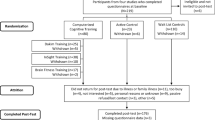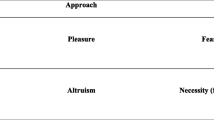Abstract
Although to-do lists are a ubiquitous daily planning tool there is limited information on users’ perceptions of this method. Another resource to support goal-oriented planning is mental imagery. A substantial body of research shows the utility of mental imagery in the domains of healthcare, sports, business and education. Imagery has been shown to enhance goal-oriented behavior, and along with primed positive affect, to enhance persistence and coping. For the purpose of comparison, a sample of 214 college students practiced either a goal-oriented mental imagery technique or a to-do list technique on alternate days for two weeks. On mental imagery days students were significantly more likely to report a sense of accomplishment, ease, coping, and positive affect, compared with to-do list days. Qualitative comments provided additional informative detail showing to-do list days to be associated with a task orientation, greater dissatisfaction with underachievement, and higher levels of perceived stress and negative affect. While the study shows benefit for both mental imagery and to-do lists, a tenable conclusion from the results is that a combination of the two methods may actually yield the greatest benefit. Used in tandem the methods provide a synergistic orientation to daily tasks with a heightened sense of positive affect and expectancy.
Similar content being viewed by others
References
Bakke, A. C., Purtzer, M. Z., & Newton, P. (2002). The effect of hypnotic-guided imagery on psychological well-being and immune function in patients with prior breast cancer. Journal of Psychosomatic Research, 53(6), 1131–1137.
Bandura, A. (1988). Self-regulation of motivation and action through goal systems. In V. Hamilton, G. H. Bower, & N. H. Frijda (Eds.), Cognitive perspectives on emotion and motivation (pp. 37–61). Dordrecht: Kluwer Academic Publishers.
Bandura, A. (1997). Self-efficacy: The exercise of control. New York: Cambridge University Press.
Barnes, P. M., Powell-Griner, E., McFann, K., & Nahin, R. L. (2004). Complementary and alternative medicine use among adults: United States, 2002. Advance Data, 27(343), 1–19.
Bartolomeo, P. (2008). The neural correlates of visual mental imagery: an ongoing debate. Cortex, 44(2), 107–108.
Batty, M., Bonnington, S., Tang, B. K., Hawken, M. B., & Gruzelier, J. H. (2006). Relaxation strategies and enhancement of hypnotic susceptibility: EEG neurofeedback, progressive muscle relaxation and self-hypnosis. Brain Research Bulletin, 71(1–3), 83–90.
Burke, A. (2004). Self hypnosis. Berkeley: Crossing Press/Ten Speed Press.
Cantor, N., & Sanderson, C. A. (1999). Life task participation and well-being: The importance of taking part in daily life. In D. Kahneman, E. Diener, & N. Schwarz (Eds.), Well-being: The foundations of hedonic psychology (pp. 230–243). New York: Russell Sage.
Cantor, N., Markus, H., Niedenthal, P., & Nurius, P. (1986). Motivation and the self concept. In R. M. Sorrentino & E. T. Higgins (Eds.), Handbook of motivation and cognition (pp. 96–121). New York: The Guilford Press.
Carlson, L. E., & Bultz, B. D. (2008). Mind-body interventions in oncology. Current Treatment Options in Oncology, 9(2–3), 127–134.
Carver, C. S., & Scheier, M. F. (1998). On the self-regulation of behavior. New York: Cambridge University Press.
Carver, C. S., Scheier, M. F., & Segerstrom, S. C. (2010). Optimism. Clinical Psychology Review, 30(7), 879–889.
Cavallaro, F. I., Cacace, I., Del Testa, M., Andre, P., Carli, G., De Pascalis, V., et al. (2010). Hypnotizability-related EEG alpha and theta activities during visual and somesthetic imageries. Neuroscience Letters, 470, 13–18.
Crawford, H. J. (1981). Hypnotic susceptibility as related to gestalt closure tasks. Journal of Personality and Social Psychology, 40(2), 376–383.
Crawford, H. (1982). Hypnotizability, daydreaming styles, imagery vividness, and absorption: a multidimensional study. Journal of Personality and Social Psychology, 42(5), 915–926.
Custers, R., & Aarts, H. (2005a). Beyond priming effects: the role of positive affect and discrepancies in implicit processes of motivation and goal pursuit. European Review of Social Psychology, 16(1), 257–300.
Custers, R., & Aarts, H. (2005b). Positive affect as implicit motivator: on the nonconscious operation of behavioral goals. Journal of Personality and Social Psychology, 89(2), 129–142.
D’Argembeau, A., Xue, G., Lu, Z. L., Van der Linden, M., & Bechara, A. (2008). Neural correlates of envisioning emotional events in the near and far future. NeuroImage, 40(1), 398–407.
Daselaar, S. M., Porat, Y., Huijbers, W., & Pennartz, C. M. A. (2010). Modality-specific and modality-independent components of the human imagery system. NeuroImage, 52(2), 677–685.
Driskell, J. E., Copper, C., & Moran, A. (1994). Does mental practice enhance performance? Journal of Applied Psychology, 79(4), 481–492.
Erez, A., & Isen, A. M. (2002). The influence of positive affect on the components of expectancy motivation. Journal of Applied Psychology, 87(6), 1055–1067.
Farah, M. J. (1989). The neural basis of mental imagery. Trends in Neurosciences, 12(10), 395–399.
Fazio, R. H., Sanbonmatsu, D. M., Powell, M. C., & Kardes, F. R. (1986). On the automatic activation of attitudes. Journal of Personality and Social Psychology, 50(2), 229–238.
Finke, R. A. (1989). Principles of mental imagery. Cambridge: The MIT Press.
Galyean, B (1982–1983). The use of guided imagery in elementary and secondary schools. Imagination, Cognition and Personality 2(2)145–151
Ganis, G., Thompson, W. L., & Kosslyn, S. M. (2004). Brain areas underlying visual mental imagery and visual perception: an fMRI study. Cognitive Brain Research, 20(2), 226–241.
Gardini, S., Cornoldi, C., De Beni, R., & Venneri, A. (2008). Cognitive and neuronal processes involved in sequential generation of general and specific mental images. Psychological Research, 73(5), 633–643.
Grant, H., & Dweck, C. S. (2003). Clarifying achievement goals and their impact. Journal of Personality and Social Psychology, 85(3), 541–553.
Harvard Business School Press. (2005). Time management: Increase your personal productivity and effectiveness. Boston: Harvard Business Review Press.
Holmes, E. A., & Mathews, A. (2010). Mental imagery in emotion and emotional disorders. Clinical Psychology Review, 30(3), 349–362.
Jacobs, G. D., & Friedman, R. (2004). EEG spectral analysis of relaxation techniques. Applied Psychophysiology and Biofeedback, 29(4).
Karniol, R., & Ross, M. (1996). The motivational impact of temporal focus: thinking about the future and the past. Annual Review of Psychology, 47, 593–620.
Klaaren, K. J., Hodges, S. D., & Wilson, T. D. (1994). The role of affective expectations in subjective experience and decision-making. Social Cognition, 12(2), 77–101.
Klauer, K. C. (1997). Affective priming. European Review of Social Psychology, 8(1), 67–103.
Knäuper, B., Roseman, M., Johnson, P. J., & Krantz, L. H. (2009). Using mental imagery to enhance the effectiveness of implementation intentions. Current Psychology, 28(3), 181–186.
Kwekkeboom, K. L. (2001). Pain management strategies used by patients with breast and gynecologic cancer with postoperative pain. Cancer Nursing, 24(5), 378–386.
Lang, P. J. (1979). A bio-informational theory of emotional imagery. Psychophysiology, 16(6), 495–512.
Lee, S., Kravitz, D. J., & Baker, C. I. (2012). Disentangling visual imagery and perception of real-world objects. NeuroImage, 59(4), 4064–4073.
Leland, K., & Bailey, K. (2008). Time management in an instant. Franklin Lakes: Career Press.
Linenberger, M. (2011). The one minute to-do list: Quickly get your chaos completely under control. San Ramon: New Academy Publishers.
Locke, E. A., Shaw, K. N., Saari, L. M., & Latham, G. P. (1981). Goal setting and task performance: 1969–1980. Psychological Bulletin, 90(1), 125–152.
Lynn, S. J., & Rhue, J. W. (1986). The fantasy-prone person: hypnosis, imagination, and creativity. Journal of Personality and Social Psychology, 51(2), 404–408.
Marino, J., Gwynn, M. I., & Spanos, N. P. (1989). Cognitive mediators in the reduction of pain: the role of expectancy, strategy use, and self-presentation. Journal of Abnormal Psychology, 98(3), 256–262.
Martin, K. A., & Hall, C. R. (1995). Using mental imagery to enhance intrinsic motivation. Journal of Sport & Exercise Psychology, 17(1), 54–69.
Martin, K. A., Moritz, S. E., & Hall, C. R. (1999). Imagery use in sport: a literature review and applied model. The Sport Psychologist, 13(3), 245–268.
McClelland, D. C. (1985). Human motivation. New York: Scott Foresman & Co.
Mellet, E., Petit, L., Mazoyer, B., Denis, M., & Tzourio, N. (1998). Reopening the mental imagery debate: lessons from functional anatomy. NeuroImage, 8(2), 129–139.
Miller, K. J., Schalk, G., Fetz, E. E., den Nijs, M., Ojemann, J. G., & Rao, R. P. N. (2010). Cortical activity during motor execution, motor imagery, and imagery-based online feedback. Proceedings of the National Academy of Sciences of the United States of America, 107(9), 4430–4435.
Morin, L., & Latham, G. (2001). The effect of mental practice and goal setting as a transfer of training intervention on supervisors. Applied Psychology, 49(3), 566–578.
Mulder, T. (2007). Motor imagery and action observation: cognitive tools for rehabilitation. Journal of Neural Transmission, 114(10), 1265–1278.
Oettingen, G., Hönig, G., & Gollwitzer, P. M. (2000). Effective self-regulation of goal attainment. International Journal of Educational Research, 33(7–8), 705–732.
Pearson, J., Clifford, C. W. G., & Tong, F. (2008). The functional impact of mental imagery on conscious perception. Current Biology, 18(13), 982–986.
Sapp, M. (1994). The effects of guided imagery on reducing the worry and emotionality components of test anxiety. Journal of Mental Imagery, 18(3–4), 165–179.
Taylor, S. E., Pham, L. B., Rivkin, I. D., & Armor, D. A. (1998). Harnessing the imagination: mental simulation, self-regulation, and coping. American Psychologist, 53(4), 429–439.
Wachelka, D., & Katz, R. C. (1999). Reducing test anxiety and improving academic self-esteem in high school and college students with learning disabilities. Journal of Behavior Therapy and Experimental Psychiatry, 30, 191–198.
Westbrook, R. A. (1980). Consumer satisfaction as a function of personal competence/efficacy. Journal of the Academy of Marketing Science, 8, 427–437.
Williams, J. D., & Gruzelier, J. H. (2001). Differentiation of hypnosis and relaxation by analysis of narrow band theta and alpha frequencies. International Journal of Clinical and Experimental Hypnosis, 49(3), 185–206.
Zemack-Rugar, Y., Bettman, J. R., & Fitzsimons, G. J. (2007). The effects of nonconsciously priming emotion concepts on behavior. Journal of Personality and Social Psychology, 93(6), 927–939.
Zimmermann-Schlatter, A., Schuster, C., Puhan, M. A., Siekierka, E., & Steurer, J. (2008). Efficacy of motor imagery in post-stroke rehabilitation: a systematic review. Journal of NeuroEngineering and Rehabilitation, 5(1), 8.
Author information
Authors and Affiliations
Corresponding author
Rights and permissions
About this article
Cite this article
Burke, A., Shanahan, C. & Herlambang, E. An Exploratory Study Comparing Goal-Oriented Mental Imagery with Daily To-Do Lists: Supporting College Student Success. Curr Psychol 33, 20–34 (2014). https://doi.org/10.1007/s12144-013-9193-2
Published:
Issue Date:
DOI: https://doi.org/10.1007/s12144-013-9193-2




